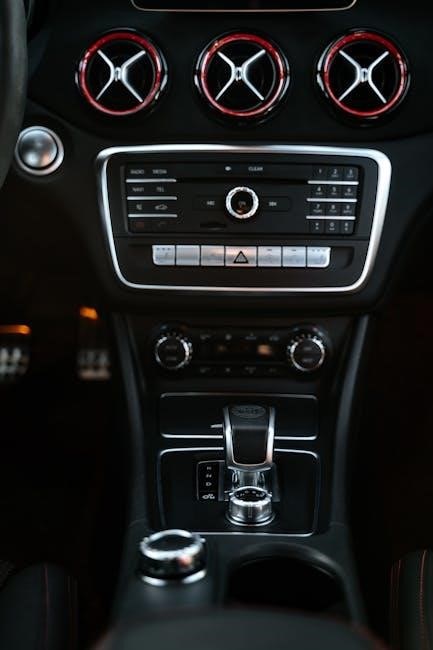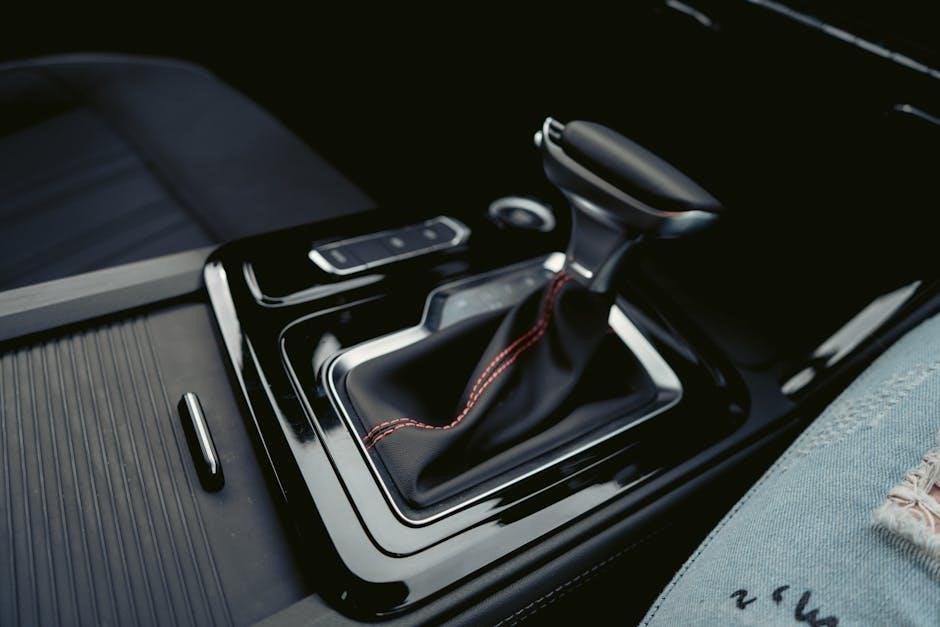An automatic starter for manual transmissions enables remote starting convenience while addressing unique challenges like clutch interlock bypass and neutral gear verification, ensuring safe and reliable operation.
What is an Automatic Starter?
An automatic starter for a manual transmission vehicle is an electronic device that enables remote starting of the engine without physical interaction with the clutch pedal or gearshift. It bypasses the clutch interlock mechanism, allowing the engine to start while ensuring the vehicle remains in neutral gear. This system is designed to provide convenience and comfort, especially in extreme weather conditions, by letting the car warm up or cool down before driving. The automatic starter integrates with the vehicle’s electrical system, ensuring safe and secure operation. It is particularly useful for manual transmission vehicles, which traditionally lack remote start functionality due to the clutch mechanism. By simulating the clutch engagement, the automatic starter overcomes this limitation, offering a seamless remote starting experience.
Why Use an Automatic Starter with a Manual Transmission?
Using an automatic starter with a manual transmission offers unparalleled convenience, allowing drivers to start their vehicles remotely without engaging the clutch or shifting gears manually. This is particularly beneficial in harsh weather conditions, such as extreme cold or heat, where preheating or cooling the car can enhance comfort. The system ensures the vehicle remains in neutral during startup, preventing accidental movement and enhancing safety. Additionally, it modernizes older manual vehicles by adding a feature typically reserved for automatics, thus increasing the car’s appeal and functionality. The ability to warm up the engine before driving also helps improve fuel efficiency and reduces wear on the engine and transmission. Overall, an automatic starter provides a practical solution for manual transmission owners seeking to enjoy the benefits of remote starting without compromising safety or functionality.

Key Components of an Automatic Starter System
A remote starter module and a clutch bypass mechanism are essential, enabling remote engine activation while ensuring the vehicle remains stationary and secure during the process.
Remote Starter Module
The remote starter module is the brain of the system, receiving signals from the remote control to initiate the starting process. It communicates with the vehicle’s electrical system to engage the ignition and fuel pump. This module ensures the engine starts smoothly and safely, even from a distance. Advanced modules often include features like multi-vehicle control and compatibility with diesel engines. They are typically installed discreetly, often near the steering column or under the dashboard, to maintain a clean appearance. The module must be programmed to work seamlessly with the vehicle’s specific electrical architecture, ensuring reliable operation and preventing unauthorized access. Proper installation and wiring are crucial for functionality and security.
Clutch Bypass Mechanism
The clutch bypass mechanism is a critical component in automatic starters for manual transmissions, enabling the system to start the engine without physical clutch engagement. This mechanism simulates the clutch pedal being pressed, allowing the starter motor to engage safely. It ensures the vehicle does not move during remote starting by maintaining neutral gear. The bypass is typically achieved through electrical signals or mechanical actuators, depending on the system design. Proper installation and calibration are essential to prevent unintended vehicle movement or damage to the transmission. The clutch bypass mechanism is a key innovation that makes remote starting possible for manual transmission vehicles, addressing the unique challenges they present compared to automatics. It ensures safe and reliable operation, making it a vital part of the system.
Challenges of Installing an Automatic Starter in a Manual Transmission Vehicle
Installing an automatic starter in a manual transmission vehicle presents unique challenges, including clutch interlock bypass, ensuring the vehicle is in neutral, and addressing safety risks.
Clutch Interlock Bypass Requirements
Bypassing the clutch interlock system is essential for remote starting in manual transmissions, as it simulates clutch engagement to allow ignition without physical pedal input. This process requires precise wiring to ensure the system safely mimics the clutch press, preventing accidental starts. Modern vehicles often have complex interlock mechanisms, making bypass installation more challenging. Specialized modules or relays may be needed to integrate the bypass effectively. Improper installation can lead to safety hazards, such as unintended vehicle movement. Therefore, careful planning and expertise are crucial to avoid risks and ensure reliable functionality. Always consult a professional to handle this critical step for guaranteed safety and performance. Proper bypass ensures the remote starter operates smoothly without compromising vehicle security or user safety.
Ensuring Vehicle is in Neutral Gear
Ensuring the vehicle is in neutral gear is critical for safe remote starting of manual transmissions. If the car isn’t in neutral, it could move unexpectedly when started, posing safety risks. Modern remote starters often include neutral-safety switches or sensors to verify the gear position. These systems prevent the engine from starting unless the transmission is in neutral. Some setups may require additional wiring or modules to monitor gear position accurately. Drivers must develop a consistent routine when parking, such as double-checking the gearshift to confirm neutral. This step is vital to prevent accidents and ensure the remote starter functions correctly. Always follow manufacturer guidelines for proper installation and operation to maintain safety and reliability. Neutral verification is a cornerstone of safe remote starting in manual transmission vehicles, protecting both the vehicle and its surroundings from potential harm.

Installation Process for an Automatic Starter
Installing an automatic starter involves connecting the remote module, integrating the clutch bypass, and wiring essential components while ensuring all safety protocols are followed carefully.
Step-by-Step Installation Guide
Begin by ensuring the vehicle is in neutral and the emergency brake is engaged. Install the remote starter module near the clutch pedal. Connect the clutch bypass mechanism to simulate clutch engagement. Wire the starter motor and ignition systems, ensuring proper connections. Integrate the emergency brake sensor for added safety. Test the system to confirm remote start functionality. Always follow manufacturer instructions and consult a professional if unsure.
Wiring and Connections
Wiring and connections are critical for proper automatic starter functionality in manual transmissions. Begin by identifying the clutch bypass wire, which simulates clutch engagement. Connect this to the remote starter module. Next, wire the starter motor and ignition systems, ensuring seamless communication. Integrate the emergency brake sensor to prevent unintended starts. Splice the neutral gear sensor wire to confirm the vehicle’s neutral state. Use high-quality wiring harnesses to avoid signal interference. Consult the vehicle’s wiring diagram for accurate connections. Properly ground all components to prevent electrical noise. Double-check all connections before testing the system. If unsure, consider professional installation to ensure safety and reliability.

Safety Features and Precautions
Safety features are crucial for automatic starters in manual transmissions, including emergency brake integration, anti-theft mechanisms, and ensuring the vehicle is in neutral to prevent unintended movement.
Emergency Brake Integration
Emergency brake integration is a critical safety feature for automatic starters in manual transmission vehicles. It ensures the vehicle remains stationary during remote starting by engaging the emergency brake. This prevents unintended movement, enhancing safety. The system typically involves sensors that monitor the emergency brake’s status, ensuring it is engaged before the engine starts. If the brake is disengaged or the vehicle detects motion, the starter will abort ignition. Proper installation requires wiring the emergency brake sensor to the remote starter module, ensuring seamless communication. This feature is vital for manual transmissions, where the risk of accidental movement is higher. Regular maintenance, such as inspecting the emergency brake and its sensors, is essential to ensure reliability and safety. By integrating the emergency brake, automatic starters provide peace of mind for drivers of manual transmission vehicles.
Anti-Theft and Security Measures
Anti-theft and security measures are essential for automatic starters in manual transmission vehicles to prevent unauthorized use and theft. Modern remote starters often include advanced security features such as encryption and rolling codes to safeguard communication between the remote and the vehicle. Additionally, many systems integrate with the vehicle’s existing alarm, ensuring that any unauthorized tampering triggers a security response. Some systems also include passive immobilization, which prevents the engine from starting unless the authorized remote is present. These measures ensure that even if a thief bypasses the ignition, the vehicle cannot be started or moved without the remote starter’s authorization. Regular updates to the system’s software and secure wiring practices further enhance security, protecting the vehicle from potential vulnerabilities. These features provide peace of mind for owners of manual transmission vehicles equipped with automatic starters.

Maintenance and Troubleshooting
Regular checks of wiring and connections ensure reliability. Software updates maintain functionality. Troubleshooting focuses on addressing issues like clutch bypass malfunctions or neutral gear misalignment in manual transmissions.
Regular Maintenance Tips
Regular maintenance ensures optimal performance of your automatic starter system. Inspect wiring and connections periodically for damage or corrosion. Check the clutch bypass mechanism to ensure proper engagement and disengagement. Verify that the vehicle consistently starts in neutral gear to prevent unintended movement. Update the system’s software regularly to maintain compatibility and functionality. Clean the remote starter module and related components to avoid dust buildup. Test the emergency brake integration to ensure it engages when the vehicle is started remotely. Finally, consult a professional if unfamiliar with any aspect of the system to avoid potential damage or safety risks.
Common Issues and Solutions
Common issues with automatic starters for manual transmissions include clutch interlock bypass malfunctions, improper neutral gear detection, and wiring connectivity problems. These issues can prevent the vehicle from starting remotely or may cause unintended movement. To resolve these, ensure the clutch bypass mechanism is properly installed and functioning. Verify that the vehicle consistently starts in neutral gear by testing the neutral switch. Check wiring connections for damage or corrosion and repair them as needed. Software glitches can also occur, so updating the system regularly is essential. If the emergency brake disengages during remote start, inspect and adjust the brake system. Finally, consult a professional if issues persist, as improper fixes can lead to safety risks or system damage. Addressing these problems promptly ensures reliable performance and safety.